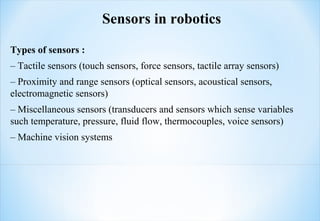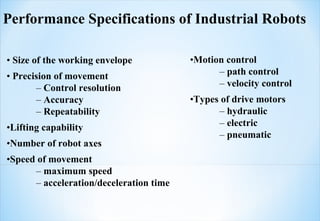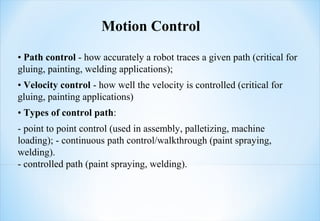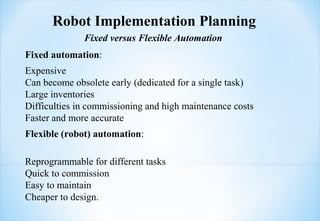Advanced manufacturing and industrial robots
- 2. “A robot is a programmable, multifunction manipulator designed to move material, parts, tools, or special devices through variable programmed motions for the performance of a variety of tasks” Robot Institute of America Industrial Robots Definition A robot is a programmable arm simulator
- 4. Motivation for using robots to perform task which would otherwise be performed by humans. • Safety • Efficiency • Reliability • Worker Redeployment • Cost reduction The Advent of Industrial Robots
- 5. – Arm or Manipulator – End effectors – Drive Mechanism – Controller – Custom features: e.g. sensors and transducers Main Components of Industrial Robots
- 6. Arm or Manipulator • The main anthropomorphic element of a robot. • In most cases the degrees of freedom depends on the arm • The work volume or reach mostly depends on the functionality of the Arm
- 7. Sensors in robotics Types of sensors : – Tactile sensors (touch sensors, force sensors, tactile array sensors) – Proximity and range sensors (optical sensors, acoustical sensors, electromagnetic sensors) – Miscellaneous sensors (transducers and sensors which sense variables such temperature, pressure, fluid flow, thermocouples, voice sensors) – Machine vision systems
- 8. Sensors in robotics Uses of sensors: – Safety monitoring – Interlocks in work cell control – Part inspection for quality control – Determining positions and related information about objects
- 9. Sensors in robotics Desirable features of sensors: Accuracy Operation range Speed of response Calibration Reliability Cost and ease of operation
- 10. • Size of the working envelope • Precision of movement – Control resolution – Accuracy – Repeatability •Lifting capability •Number of robot axes •Speed of movement – maximum speed – acceleration/deceleration time •Motion control – path control – velocity control •Types of drive motors – hydraulic – electric – pneumatic Performance Specifications of Industrial Robots
- 11. •Acceleration/deceleration times are crucial for cycle time. •Determined by – Weight of the object – Distance moved – Precision with which object must be positioned Speed of Movement Speed with which the robot can manipulate the end effector
- 12. • Path control - how accurately a robot traces a given path (critical for gluing, painting, welding applications); • Velocity control - how well the velocity is controlled (critical for gluing, painting applications) • Types of control path: - point to point control (used in assembly, palletizing, machine loading); - continuous path control/walkthrough (paint spraying, welding). - controlled path (paint spraying, welding). Motion Control
- 13. • Hydraulic – High strength and high speed – Large robots, Takes floor space – Mechanical Simplicity – Used usually for heavy payloads • Electric Motor (Servo/Stepper) – High accuracy and repeatability – Low cost – Less floor space – Easy maintenance • Pneumatic – Smaller units, quick assembly – High cycle rate – Easy maintenance Type of Drive System
- 14. Robot Implementation Planning Identify Objectives (Benefits) • Increase productivity • Reduce labor cost • Reduce cycle time • Eliminate undesired jobs • Safety reasons: protect from exposure to hazardous conditions • Increase product quality
- 15. Robot Implementation Planning Consider Drawbacks • The impact upon the workers • The impact upon production schedule and maintenance • Questions of potential model changes or process changes
- 16. Fixed automation: Expensive Can become obsolete early (dedicated for a single task) Large inventories Difficulties in commissioning and high maintenance costs Faster and more accurate Flexible (robot) automation: Reprogrammable for different tasks Quick to commission Easy to maintain Cheaper to design. Robot Implementation Planning Fixed versus Flexible Automation
















